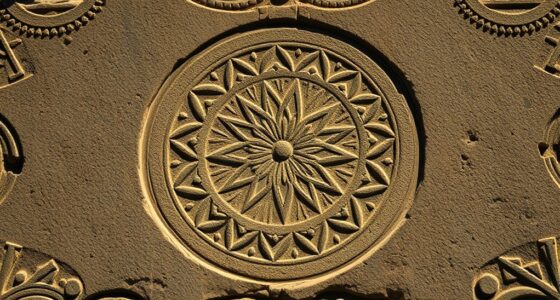Sacred shapes in mythology act as a universal language that encodes cosmic principles and spiritual truths. When you see symbols like circles, triangles, or spirals, they represent concepts like eternity, stability, or growth, connecting you to higher domains and timeless legends. These geometric patterns embody divine order and sacred knowledge, serving as bridges between material and spiritual worlds. Exploring these mystical symbols reveals more about ancient beliefs and cosmic connections, inviting you to uncover deeper meanings behind the legends.
Key Takeaways
- Sacred shapes like circles, triangles, and spirals symbolize universal truths, spiritual principles, and cosmic order in myths.
- Geometric symbols encode sacred knowledge, divine laws, and cosmic connections within legendary narratives.
- Mythical architecture employs precise geometric patterns to represent divine elevation, protection, and spiritual harmony.
- Sacred geometries serve as visual language, conveying complex spiritual concepts and linking material and spiritual realms.
- These shapes function as universal symbols guiding, protecting, and enlightening those seeking divine understanding.

Have you ever wondered how ancient myths incorporate geometric shapes and concepts? It’s fascinating to see how sacred geometries and mythical symbols intertwine in stories from cultures around the world. These shapes aren’t just decorative; they hold deep symbolic meaning and are believed to reveal universal truths or divine patterns. When you explore mythologies, you’ll notice that certain shapes recur, representing fundamental principles of existence, spirituality, and cosmic order. These geometric forms serve as visual language, conveying complex ideas in simple, recognizable symbols.
Ancient myths use sacred shapes to symbolize universal truths and cosmic principles in a visual language.
Sacred geometries are at the core of many legendary tales. For example, the circle often symbolizes eternity, wholeness, and the infinite cycle of life and death. In myths, it’s frequently associated with divine or cosmic entities—think of the ouroboros, a serpent eating its tail, which encapsulates the idea of eternal renewal. The triangle, with its three points, can represent stability, balance, or the trinity of gods or principles. In Egyptian mythology, the pyramids employ precise geometric proportions, symbolizing ascent and spiritual elevation. These shapes aren’t accidental; they are intentionally designed to embody sacred truths and connect humans with higher domains.
Mythical symbols often incorporate these geometric forms to communicate powerful messages. The star or pentagram, for instance, is seen in various cultures as a symbol of protection, harmony, or the union of spirit and matter. In Greek mythology, the star-shaped pattern appears in sacred architecture and art, illustrating divine order. Similarly, the spiral, another common motif, signifies growth, evolution, and the journey of the soul. Its continuous curve reflects the cyclical nature of life and the universe. When you study ancient legends, you’ll find that these symbols aren’t just artistic embellishments—they encode sacred knowledge passed down through generations.
Understanding how these symbols function within mythology reveals that geometry isn’t merely a mathematical discipline but a universal language that connects the material and spiritual worlds. Mythical symbols often employ geometric shapes to represent divine principles, sacred spaces, or cosmic laws. They serve as a bridge, helping humans grasp the mysteries of existence. By recognizing these geometric patterns, you can gain insight into the worldview of ancient cultures, where every shape carried profound meaning. In essence, sacred geometries in mythology aren’t just decorative elements—they’re timeless symbols of spiritual truth, woven into the fabric of legends to guide, protect, and enlighten those who seek understanding.
Frequently Asked Questions
How Did Ancient Cultures Discover These Sacred Shapes Independently?
You might find that ancient cultures discovered sacred shapes independently through observation and practical use. As they explored their environment, they noticed natural patterns and proportions, leading to geometric understanding. These shapes held cultural symbolism, representing spiritual beliefs or societal ideals. Such discoveries often occurred without direct contact, showing how universal human curiosity and shared experiences fostered independent recognition of these sacred forms across different civilizations.
Are There Math Principles Behind the Sacred Geometric Shapes?
Yes, there are math principles behind sacred geometric shapes. You’ll find that many are based on mathematical ratios, like the golden ratio, which creates harmony and balance. Geometric proofs show how these shapes follow specific rules, such as symmetry and proportionality, revealing their deep mathematical foundation. These principles help explain why ancient cultures considered these shapes sacred, as they embody universal truths and natural harmony.
Do These Mythological Shapes Influence Modern Architecture or Design?
You see sacred shapes in modern architecture and design, like the Fibonacci spiral in a museum’s facade or the Vesica Piscis in a cathedral’s windows. These mythological geometric symbols influence architectural symbolism, adding harmony and spiritual meaning. As you walk through contemporary spaces, notice how these ancient shapes subtly shape your experience, blending mythic symbolism with innovative design to create structures that resonate deeply and stand timeless.
How Do Sacred Shapes Relate to Spiritual or Religious Beliefs?
Sacred shapes embody symbolic meanings that deepen your spiritual understanding and connection. They serve as visual representations of spiritual symbolism, helping you focus your beliefs and intentions. When you see these shapes in religious or mythological contexts, they reinforce your faith, conveying divine principles or cosmic order. By engaging with these sacred forms, you tap into a universal language that links your spiritual journey to ancient wisdom and enlightened traditions.
Are These Shapes Found in Myths Worldwide, or Are They Culture-Specific?
You’ll find sacred shapes in myths worldwide, proving that universal symbolism spans cultures, but cultural variations give each shape unique meaning. It’s like different strokes for different folks; these shapes appear across mythologies, from the circle in Native American legends to the mandala in Hindu traditions. While their core significance often overlaps, local stories and beliefs give each sacred shape a distinct cultural flavor, making the global tapestry rich and diverse.
Conclusion
As you walk through the tapestry of myths, you realize sacred shapes are like hidden keys revealing ancient wisdom. These geometric figures are the silent storytellers, bridging the divine and the earthly. Just as a compass guides a traveler, geometry guides your understanding of legends, revealing that shapes aren’t just lines and angles—they’re the heartbeat of sacred stories. Embrace these symbols, and let them lead you on a journey through myth’s timeless landscape.









